Quick Look
Grade Level: 6 (5-7)
Time Required: 15 minutes
Lesson Dependency:
Subject Areas: Earth and Space, Science and Technology
NGSS Performance Expectations:

| MS-ESS3-4 |
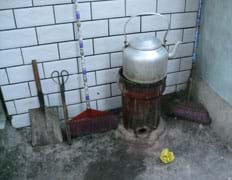
Summary
Through an overview of some of the environmental challenges facing the growing and evolving country of China today, students learn about the effects of indoor and outdoor air pollution that China is struggling to curb with the help of engineers and scientists. This includes the sources of particulate matter 2.5 and carbon dioxide, and air pollution impacts on the health of people and the environment.Engineering Connection
Some environmental engineers focus their work on helping people obtain access to clean water, sanitation and clean air. China's rapid growth puts a lot of pressure on the nation to meet its energy demands. Engineers are trying to find ways to increase energy efficiency measures and the amount of renewable energy availability. The hope is to reduce environmental and air pollution levels with efforts that reduce energy consumption and use cleaner sources of energy.
Learning Objectives
After this lesson, students should be able to:
- List two negative effects of outdoor air pollution (acid rain, ozone depletion, global warming, climate change).
- List two negative effects of indoor air pollution (acute respiratory infections, chronic obstructive pulmonary disease, lung cancer, possibly cataracts and low birth-weight).
- List two major pollutants environmental engineers are concerned about (CO2 and PM2.5).
Educational Standards
Each TeachEngineering lesson or activity is correlated to one or more K-12 science,
technology, engineering or math (STEM) educational standards.
All 100,000+ K-12 STEM standards covered in TeachEngineering are collected, maintained and packaged by the Achievement Standards Network (ASN),
a project of D2L (www.achievementstandards.org).
In the ASN, standards are hierarchically structured: first by source; e.g., by state; within source by type; e.g., science or mathematics;
within type by subtype, then by grade, etc.
Each TeachEngineering lesson or activity is correlated to one or more K-12 science, technology, engineering or math (STEM) educational standards.
All 100,000+ K-12 STEM standards covered in TeachEngineering are collected, maintained and packaged by the Achievement Standards Network (ASN), a project of D2L (www.achievementstandards.org).
In the ASN, standards are hierarchically structured: first by source; e.g., by state; within source by type; e.g., science or mathematics; within type by subtype, then by grade, etc.
NGSS: Next Generation Science Standards - Science
| NGSS Performance Expectation | ||
|---|---|---|
|
MS-ESS3-4. Construct an argument supported by evidence for how increases in human population and per-capita consumption of natural resources impact Earth's systems. (Grades 6 - 8) Do you agree with this alignment? |
||
| Click to view other curriculum aligned to this Performance Expectation | ||
| This lesson focuses on the following Three Dimensional Learning aspects of NGSS: | ||
| Science & Engineering Practices | Disciplinary Core Ideas | Crosscutting Concepts |
| Construct an oral and written argument supported by empirical evidence and scientific reasoning to support or refute an explanation or a model for a phenomenon or a solution to a problem. Alignment agreement: | Typically as human populations and per-capita consumption of natural resources increase, so do the negative impacts on Earth unless the activities and technologies involved are engineered otherwise. Alignment agreement: | Cause and effect relationships may be used to predict phenomena in natural or designed systems. Alignment agreement: All human activity draws on natural resources and has both short and long-term consequences, positive as well as negative, for the health of people and the natural environment.Alignment agreement: Scientific knowledge can describe the consequences of actions but does not necessarily prescribe the decisions that society takes.Alignment agreement: |
Common Core State Standards - Math
-
Model with mathematics.
(Grades
K -
12)
More Details
Do you agree with this alignment?
International Technology and Engineering Educators Association - Technology
-
Students will develop an understanding of the effects of technology on the environment.
(Grades
K -
12)
More Details
Do you agree with this alignment?
-
The management of waste produced by technological systems is an important societal issue.
(Grades
6 -
8)
More Details
Do you agree with this alignment?
-
Analyze how different technological systems often interact with economic, environmental, and social systems.
(Grades
6 -
8)
More Details
Do you agree with this alignment?
-
Analyze how the creation and use of technologies consumes renewable and non-renewable resources and creates waste.
(Grades
6 -
8)
More Details
Do you agree with this alignment?
Worksheets and Attachments
Visit [www.teachengineering.org/lessons/view/cub_china_lesson01] to print or download.Introduction/Motivation
(In advance, prepare computer projector or overhead transparencies to show students the attached Air Pollution in China PowerPoint presentation. Its 16 slides cover the population and growth happening in China, air pollutants and sources, and resulting effects of indoor and outdoor air pollution.)
(Hold up a globe or point to a world map if you have one.) Who can tell me where in the world China is? That's right! China is a big country; it is about the same land size as the U.S., but with a lot more people.
Does anyone know how many people live in the U.S.? (About 300 million.) Well, about 1.3 BILLION people live in China – that's more than four times as many people as we have in the U.S.
Right now, China's economy is growing very rapidly. That means that the country is creating more businesses and making products and profits, which is a good thing, but it has some consequences. We're going to talk about some of the consequences today. One consequence is environmental pollution. China is struggling with water pollution, soil erosion, desertification, and air pollution.
Today we're going to focus on learning about air pollution in China. Our learning goals for our lesson are to learn two problems that result from outdoor air pollution, two problems with indoor air pollution, and two major pollutants that scientists and engineers are concerned about.
(Proceed to show students the attached PowerPoint presentation. Then lead-into the associated activity Design a Net-Zero Energy Classroom with the following introduction.)
We know that China is a huge country, with more than a billion people, and its new industry and commerce are creating huge increases in air pollution and energy demand at a rapid pace. Even rural China is now 99% electrified. In the U.S, we use a huge amount of energy, too. Our buildings consume about 40% of all energy that is used! Most of this energy is produced by burning non-renewable fossil fuels (such as coal) that create a lot of pollution and cause environmental problems.
What can we do about it? Well, we can do two things to help the environment: conserving energy (using less) and using "clean" energy. If we save energy, then we use less overall, even if some of it isn't "clean." We also need to be more energy efficient. What does that mean? (Listen to student suggestions.) Energy efficiency means that we make the energy we have go a lot further with as little waste as possible. For example, a well-insulated house doesn't need as much energy to keep it cozy inside during cold weather. Having windows in a classroom reduces the need to turn on lights during the daytime. And more and more household appliances and devices (such as high-efficiency furnaces, LED light bulbs, solar water heaters, etc.) are being designed to use less energy and/or use renewable energy to do the same tasks.
China needs to be more energy efficient — and America does, too. Even you can do things to help the environment by saving energy, just as engineers are doing. If we all work together, it adds up, and we can save a lot of energy. Conserving energy and being more energy efficienct are ways we can all pitch in.
How is energy used in buildings? It takes energy to heat and cool buildings so that we feel comfortable. We need energy for lights so we can see. Energy is used to power computers, TVs, fans and most electrical appliances. We also use energy for heating water, cooking and baking, other everyday tasks. Can you spot a few things in this classroom that use energy? (Listen to student suggestions.) Essentially, everything we plug into the wall uses energy. Can you imagine what life would be like without easy access to energy in our buildings, homes and schools?
We need the ability to produce energy, but we also need to be environmentally responsible and wisely use the energy we have. Here's an idea: Can you imagine a building that actually generates as much energy as it uses? This is called a net-zero energy building. Homes, offices, stores and even schools can be net-zero energy buildings. Today we are going to redesign our classroom so that it is a net-zero energy classroom.
(Proceed to conduct the associated activity.)
Lesson Background and Concepts for Teachers
About 1.3 billion people live in China today, with around 60% living in rural areas. However, this number is rapidly changing as millions of people move to the cities to pursue jobs in factories or other employment. Even in the beautiful Chinese countryside people have many struggles —with their health, income, and clean air. 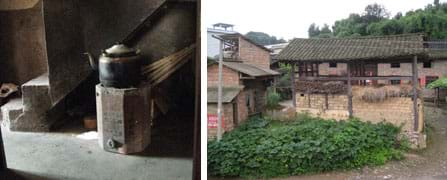
Indoor Air Pollution in Rural China
Many people in the Chinese countryside use coal to cook their meals and heat their homes. Figure 1 shows a coal stove that a family uses to make tea. When families use small stoves like this one, with no chimney, emissions from the coal pollute the quality of their indoor air and can enter their lungs and cause health problems. Small stoves like this one, that families use for cooking, are called cookstoves.
About 700 million people (that's more than twice the population of the U.S.) living in rural areas of China, burn stuff. The "stuff" they burn can be straw, rice husks, corn husks, corn cobs, dung, wood or coal, with varying impacts on the environment. Nearly 3 billion people in the world use cookstoves or open fires, to cook their meals. The burning of these "solid fuels" can produce exceedingly high levels of indoor air pollution. In China, the commonly-burned cylindrical briquettes of charcoal, known as "honeycomb" coal, are a mixture of clay and coal, and burn very dirtily. One of the worst components of indoor air pollution is particulate matter, which are very small air-borne particles that can cause health problems when breathed into our lungs.
Some of the health effects that caused by indoor air pollution are acute respiratory infections, chronic obstructive pulmonary disease (COPD), and lung cancer. Chronic obstructive pulmonary disease gets worse over time, causing coughing, wheezing, shortness of breath and other symptoms. Indoor air pollution may also increase the risk of are cataracts and low birth-weight. Scientists and engineers have found that indoor air pollution is responsible for the premature death of 1.9 million people each year. Women and children are often more affected, since they may be doing the cooking or playing inside near fires and stoves.
Scientists and engineers are researching and designing solutions so that families who do not have much income can cook in alternate ways that are less harmful to their health. This topic is explored in more detail in a later lesson in this unit: Rural Energy in China: How Can Engineers Make a Difference? and its associated activity.
Outdoor Air Pollution in Big Cities in China
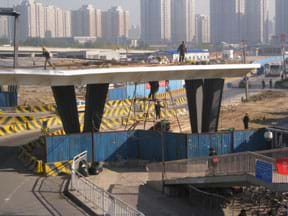
Even though many families still live in rural areas, millions of people are moving to the cities, and the cities are growing rapidly. Beijing, the capital city, now has more than 20 million people, more than twice the population of New York City. As people's incomes increase, they are able to afford more material goods and luxuries. The number of cars in Beijing is drastically increasing — at one point, Beijing was receiving some 2,000 new cars on the road per day! All of the new construction (see Figure 2) and new cars in Beijing (and in other big cities in China) leads to increased outdoor air pollution.
Air Pollutants and Effects
Two of the outdoor and indoor air pollutants that engineers and scientists are concerned about are carbon dioxide (CO2) and particulate matter 2.5 (PM2.5).
Particulate matter 2.5 (PM2.5) are very small pieces of pollution (the 2.5 refers to size; they are 2.5 micrometers or less across in diameter). These particles are so small that they can go deep inside our lungs, which can lead to serious health problems.
Researchers have used NASA satellite data and a computer model to create the map in Figure 3, which shows average global PM2.5 levels from 2001-2006. As you can see, most of the U.S. has relatively low levels of PM2.5, while many developing areas of the world, such as northern Africa, India and China have extremely high levels. In fact, the area around the city of Beijing is one of the darkest areas on this map.
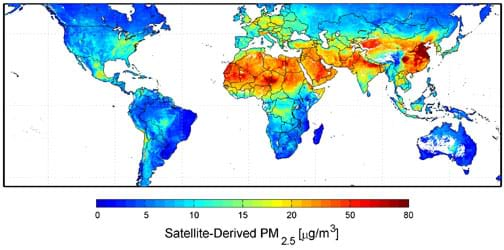
The other pollutant that scientists and engineers are very concerned about is carbon dioxide, or CO2. Industrial processes, such as burning oil or gasoline (to power our vehicles), produce carbon dioxide, and levels of carbon dioxide have been increasing over time. Plants and oceans are able to absorb a lot of CO2, but since we're producing so much, it is creating some significant problems now.
According to the U.S. Environmental Protection Agency, in 2005, carbon dioxide levels were 35% higher than they were during the industrial revolution in the 1700s. Some scientists and engineers are worried that carbon dioxide in increasingly high concentrations may have serious environmental consequences for our planet. Too much carbon dioxide can lead to global warming, and may cause climate change.
By using Google Public Data Explorer (an online program to track different parameters; anyone can use it), we can look back over time to see how pollution levels have changed. Both population and carbon dioxide (CO2) emissions have changed much during the past 40 or so years. Figure 4 shows how CO2 levels have increased in different countries. (Each dot is a year, going back from 2007.) We can see that emissions have dramatically increased in China as their population increased during the past few decades, and we can also see that for a long time, the U.S. had the highest CO2 emissions, but China has recently surpassed the U.S. as the world's largest emitter of CO2. India's emissions have also been increasing, while many other countries' emissions levels have stayed relatively stable (relative to the huge increases seen in China at least).
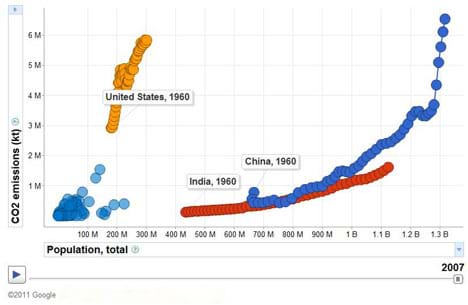
The graph in Figure 4 graph also shows that China has many more people than America. The U.S. and China are the two largest energy consumers in the entire world. While the U.S. has fewer people than China, on average, per person, the U.S. consumes much more energy than China. Many reasons explain this, but knowing this astonishing fact can help us start thinking about ways that we can save energy every day (the topic for a later lesson in this unit).
Other outdoor air pollution effects include acid rain and ozone depletion. Acid rain occurs when sulfurous and nitrous gasses (SO2 and NOx) react with water, oxygen and other chemicals in the atmosphere to form acidic compounds. These compounds can fall either in dry form through dust or smoke, or in wet form through rain, fog or snow. Acid rain appears to be a problem in 200 of 440 monitored cities in China.
Ozone depletion occurs when chemicals such as chlorofluorocarbons and hydrofluorocarbons are affected by ultraviolet radiation from the sun when they reach the stratosphere. This causes them to release chlorine atoms that react with ozone and can cause ozone destruction and the depletion of the ozone layer. Other chemicals can also harm the ozone layer.
Moving Forward
China is trying in many ways to take better care of the environment, but the task is huge. Engineers are helping people to use cleaner energy in the city and countryside. Some of the efforts that have been tried so far are shutting down factories, making more stringent auto emissions standards, and a program to reduce the amount of coal used for home heating. Additional efforts include programs to reduce the number of cars permitted to drive on specific days in Beijing, and a ban on free plastic bags at stores. Many of the efforts being implemented by engineers and citizens in China are relevant for what engineers and young students in other countries can do to help reduce energy usage in their own communities.
Notes on the Associated Activity
After showing the attached presentation, conduct the associated Design a Net-Zero Energy Classroom activity in which students create concept designs of functioning rooms that produce as much energy as they use. To transition from an examination of the indoor and outdoor pollution challenges in China, lead-in with the (modified) activity Introduction/Motivation provided in this lesson. Then, after the activity, lead a class discussion to bring the net-zero concepts back to their applicability in China and students' lives. The main idea is that China is using more and more energy at a incredibly rapid pace, so in order to help with air pollution and global impacts China (as well as other countries) needs to use renewable sources of energy, conserve energy and be more energy efficient. In later lessons/activities in this unit, students are presented with more information and activities on roof and home design suitable for specific climates, and the optimization of cleaner energy solutions for cooking and heating.
Associated Activities
- Design a Net-Zero Energy Classroom - Students create concept designs of their own net-zero energy classrooms by pasting renewable energy and energy-efficiency items into and around hypothetical classroom layouts on paper. They learn how these items (such as solar panels, efficient lights, computers, energy meters, etc.) interact to create living spaces that produce as much energy as they use.
Lesson Closure
You all have done a terrific job today learning about China, and indoor and outdoor air pollution issues in that country! Do you remember the two pollutants engineers and scientists are measuring and trying to reduce in the air? (Answer: Carbon dioxide and particulate matter 2.5).
What's so bad about air pollution? Can anyone tell me a few of the negative effects of outdoor air pollution? (Answers: Acid rain, ozone depletion, global warming, climate change, and a health hazard to breath in smoggy cities.) What about indoor air pollution? (Answer: Negative effects include damaging of your lungs from breathing pollutants, causing poor health and more serious diseases such as acute respiratory infection, chronic obstructive pulmonary disease, lung cancer, and possibly low-birth weight babies and cataracts.)
As we continue to learn about environmental challenges in China, we will discover more about how we can help save energy and use renewable energy. We'll also learn ways that engineers help people in the countryside use cleaner forms of energy.
Vocabulary/Definitions
acid rain: Acidic wet or dry deposition caused by the reaction of sulfurous and nitrous gasses with water, oxygen and other chemicals in the atmosphere.
carbon dioxide: The gas that humans emit when breathing, and is emitted when from burning fuels. Oceans and plants can take up carbon dioxide, but when too much is in the atmosphere it may lead to global warming. (CO2)
chronic obstructive pulmonary disease: (COPD) A disease that makes it hard for people to breathe. Causes include smoking and air pollution.
cook stove: Stove used for cooking.
non-solid fuel: Energy sources for cooking or heating that are non-solid, such as gasoline, electricity, biogas or propane.
ozone depletion : Depletion of the ozone layer caused by reaction of chemicals with ultraviolet radiation and ozone in the stratosphere.
particulate matter: (PM 2.5) Small particles (2.5 micrometers or less in diameter) that can lodge deep inside our lungs and lead to serious health effects. (PM2.5)
solid fuel: Energy sources for cooking and heating that are solid, such as coal, wood, dried cornstalks, dung or other solid biomass materials.
Assessment
Pre-Unit Quiz: If this is the first day of the Environmental Challenges in China unit and you are teaching the entire unit, administer the 10-question Pre-Unit Quiz, as described and attached in the unit document, before beginning any discussion of the lesson subject matter.
Writing Recap: After showing the attached PowerPoint presentation, assess students' comprehension and retention by asking them to write in their notebooks the answers to the learning objectives. As time permits, review their answers (found on the last slide) as you conclude the lesson.
- What are two types of pollutants engineers and scientists are concerned about?
- What are two effects of outdoor air pollution?
- What are two effects of indoor air pollution?
Argument: Have students construct an argument supported by evidence for how increases in human population and per-capita consumption of natural resources impact Earth's systems.
Wrap-Up Discussion: Verify students understanding of the net-zero concepts explored in the associated activity by leading a class discussion that asks them to apply what they did to create a net-zero classroom to: 1) what people could do in China, and 2) what changes they could make in their own lives. For example, China is using so much energy and growing so quickly, increasing usage of renewable energy sources is one avenue to help people's health as well as the health of the environment. This might include on-site wind and solar electrical generation in rural areas, wind farms and solar farms for generating electricity to supply cities, stoves and heaters that use electricity from renewable energy instead of coal, using bicycles instead of cars for transportation, etc.
Lesson Extension Activities
If a computer lab is available, give students time to explore environmental data and create their own graphs showing how different environmental metrics have changed in various countries during the past decades (such as the Figure 4 graph). Use the Google Public Data Explorer, described more in the Additional Multimedia Support section.
For more advanced students, assign each to read different articles from the New York Times' 10-part series on growth in Chiina and give class reports recapping what they learned. See more on this resource in the Additional Multimedia Support section.
Additional Multimedia Support
The free-to-use Google Public Data Explorer is a great tool for researching how different data categories interact and practicing interacting with graphs. Users can choose from variety of data sets, and then choose the x and y axis to see how different factors interact. For the Figure 4 example, the World Development Indicators (subset) from the World Bank was used. See http://www.google.com/publicdata/directory
The New York Times published an excellent 10-part series called, "Choking on Growth," describing environmental challenges in China (overview, water crisis, activists, three-gorges dam, energy, wildlife threatened, polluting trucks, farming fish, two steel towns, green Olympics under gray skies). It also includes excellent photographs. See http://www.nytimes.com/interactive/2007/12/29/world/asia/choking_on_growth_10.html
Subscribe
Get the inside scoop on all things TeachEngineering such as new site features, curriculum updates, video releases, and more by signing up for our newsletter!More Curriculum Like This

Students are introduced to the concepts of air pollution, air quality, and climate change. The three lesson parts (including the associated activities) focus on the prerequisites for understanding air pollution. First, students use M&M® candies to create pie graphs that express their understanding o...
References
Acid Rain. Last updated March 24, 2011. U.S. Environmental Protection Agency. Accessed June 25, 2011. http://www.epa.gov/acidrain/
Beijing. Last modified June 23, 2011. Wikipedia. Accessed June 25, 2011. http://en.wikipedia.org/wiki/Beijing
Brief Questions and Answers on Ozone Depletion. Last updated August 19, 2010. U.S. Environmental Protection Agency. Accessed June 25, 2011. http://www.epa.gov/ozone/science/q_a.html
Carbon Dioxide. Last updated April 15, 2011. U.S. Environmental Protection Agency. Accessed June 25, 2011. http://www.epa.gov/climatechange/emissions/co2.html
Carbon Dioxide. Last modified June 25, 2011. Wikipedia. Accessed June 25, 2011. http://en.wikipedia.org/wiki/Carbon_dioxide
China, The World Factbook. Last updated June 15, 2011. Central Intelligence Agency. Accessed June 25, 2011. https://www.cia.gov/library/publications/the-world-factbook/geos/ch.html
"China Bans Free Plastic Shopping Bags." Published January 9, 2008. New York Times. Accessed June 25, 2011. http://www.nytimes.com/2008/01/09/world/asia/09iht-plastic.1.9097939.html
Global Alliance for Clean Cookstoves. United Nations Foundation. Accessed June 25, 2011. (a public-private initiative to save lives, improve livelihoods, empower women, and combat climate change by creating a thriving global market for clean and efficient household cooking solutions) http://www.cleancookstoves.org/
Google Public Data Explorer Accessed June 25, 2011. http://www.google.com/publicdata/directory
Health Effects. Indoor Air Pollution. World Health Organization. Accessed June 25, 2011. http://www.who.int/indoorair/health_impacts/disease/en/index.html
Indoor Air Pollution. World Health Organization. Accessed June 25, 2011. http://www.who.int/indoorair/en/
Jacobs, Andrew. "In China, Pollution Worsens Despite New Efforts." Published July 28, 2010. New York Times. Accessed June 25, 2011. http://www.nytimes.com/2010/07/29/world/asia/29china.html?_r=1
Outdoor Air Pollution. Lawrence Berkeley National Laboratory. Accessed June 25, 2011. (short descriptions on smog, temperature inversion, acid rain, greenhouse gases and ozone depletion) http://www.lbl.gov/Education/ELSI/Frames/pollution-outdoor-f.html
Particulate Matter. Last updated March 16, 2011. U.S. Environmental Protection Agency. Accessed June 25, 2011. http://www.epa.gov/pm/
What Can Pollution Do? Impacts on Your Health. American Lung Association, Washington DC. Accessed June 25, 2011. http://www.lungusa.org/healthy-air/outdoor/protecting-your-health/impacts-on-your-health/
What is COPD? Diseases and Conditions Index. National Heart Lung and Blood Institute. Accessed June 25, 2011. http://www.nhlbi.nih.gov/health/dci/Diseases/Copd/Copd_WhatIs.html
Xiaohua, Cui. Updated April 8, 2010. "Continued Driving Restriction Upsets City's Car Owners." China Daily. Accessed June 25, 2011. http://www.chinadaily.com.cn/metro/2010-04/08/content_9701838.htm
Copyright
© 2009 by Regents of the University of ColoradoContributors
Abigail T. Watrous (This material developed in part during Watrous' China Fulbright fellowship in 2009-10. Sincere thanks to the U.S. State Department and the Fulbright Program for their support.); Stephanie Rivale; Janet Yowell; Denise W. CarlsonSupporting Program
Integrated Teaching and Learning Program, College of Engineering, University of Colorado BoulderAcknowledgements
The contents of this digital library curriculum were developed under a grant from the Fund for the Improvement of Postsecondary Education (FIPSE), U.S. Department of Education and National Science Foundation GK-12 grant no. 0338326. However, these contents do not necessarily represent the policies of the Department of Education or National Science Foundation, and you should not assume endorsement by the federal government.
Last modified: April 5, 2020






User Comments & Tips